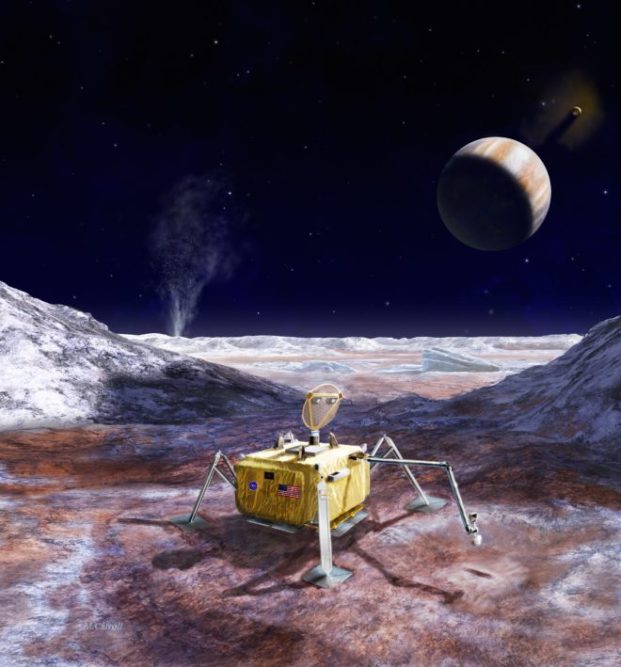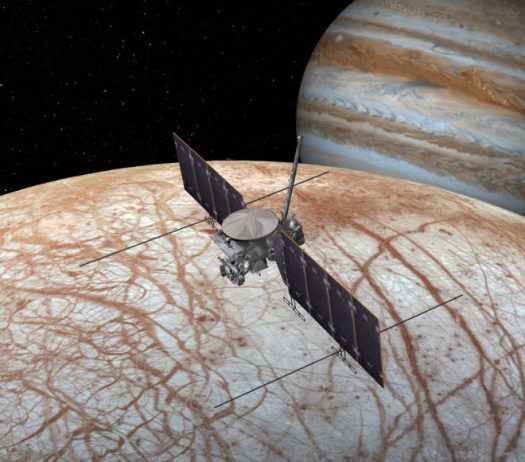
It has been four long decades since NASA has sent an officially-designated life detection mission into space. The confused results of the Viking missions to Mars in the mid 1970s were so controversial and contradictory that scientists — or the agency at least — concluded that the knowledge needed to convincingly search for extraterrestrial life wasn’t available yet.
But now, a panel of scientists and engineers brought together by NASA has studied a proposal to send a lander to Jupiter’s moon Europa and, among other tasks, return to the effort of life-detection.
In their recommendation, in fact, the NASA-appointed Science Definition Team said that the primary goal of the mission would be “to search for evidence of life on Europa.”
The other goals are to assess the habitability of Europa by directly analyzing material from the surface, and to characterize the surface and subsurface to support future robotic exploration of Europa and its ocean.
Scientists agree that the evidence is quite strong that Europa, which is slightly smaller than Earth’s
moon, has a global saltwater ocean beneath its deep ice crust, and that it contains twice as much water as exists on Earth.
For the ocean to be liquid there must be substantial sources of heat — from tidal heating based on the shape of its orbits, or from heat emanating from radioactive decay and entering the ocean through hydrothermal vents. All could potentially provide an environment where life could emerge and survive.
Kevin Hand of the Jet Propulsion Laboratory is a specialist in icy worlds and is deputy project scientist for the Europa project. He was one of the co-chairs of the Science Definition Team (SDT) and he said the group was ever mindful of the complicated history of the Viking missions. He said that some people called Viking a “failure” because it did not clearly identify life, but he described that view as “entirely unscientific.”
“It would be misguided to set out to ‘find life’,” he told me. “The real objective is to test an hypothesis – one we have that if you bring together the conditions for life as we know them, then they might come together and life can inhabit the environment.
“As far as we can tell, Europa has the water, the elements and the energy needed to create a habitable world. If the origin of life involves some relatively easy processes, then it just might be there on Europa.”

The conclusions of the SDT team, which is made is up of dozens of scientists and engineers, will set the stage for further review, rather than for immediate action. The report goes to NASA, where it is assessed in relation to other compelling and competing missions. Both the Congress and White House can and do weigh in.
If it is approved, the Europa lander mission would be a companion to the already funded Europa multiple flyby mission scheduled to launch in the 2020s. While that spacecraft, the Europa Clipper, would have some capacity to determine whether or not the icy moon is habitable, a lander would be needed to search for actual signs of life.
A mission to Europa was a top priority of the 2010 Decadal Review, a synthesis of potential projects in various disciplines that is reviewed by the National Research Council of the National Academy of Sciences.

Its recommendations from the Decadal Review are generally followed by NASA. It remains unclear whether the Europa lander is a natural follow-on to the Europa Clipper or a new initiative to be judged on its own. But the project does have strong support — last year Rep. John Culberson (R-Tex.) pushed a bill through Congress making it illegal to not send a lander to Europa.
Although there are many hurdles to clear for the Europa lander, the SDT report is nonetheless a rather momentous event since it strongly recommends a life-detection mission. So I thought it was worthwhile to include the entire preface of the teams’s conclusions.
“The Europa Lander Science Definition Team Report presents the integrated results of an intensive science and engineering team effort to develop and optimize a mission concept that would follow the Europa Multiple Flyby Mission and conduct the first in situ search for evidence of life on another world since the Viking spacecraft on Mars in the 1970s.
The Europa Lander mission would be a pathfinder for characterizing the biological potential of Europa’s ocean through direct study of any chemical, geological, and possibly biological, signatures as expressed on, and just below, the surface of Europa. The search for signs of life on Europa’s surface requires an analytical payload that performs quantitative organic compositional, microscopic, and spectroscopic analysis on five samples acquired from at least 10 cm beneath the surface, with supporting context imaging observations.
This mission would significantly advance our understanding of Europa as an ocean world, even in the absence of any definitive signs of life, and would provide the foundation for the future robotic exploration of Europa.”
(Here is the full Europa lander SDT report.)

Hand said that a lander would be a natural complement to the Europa Clipper, which is being designed to orbit Jupiter and pass by Europa 45 times at altitudes varying from 1675 miles to 16 miles. The flybys, he said, could potentially identify cracks and fissures in the crust of the moon, and thereby help identify where a lander should touch down.
What’s more, images taken by the Hubble Space Telescope in 2012 suggest that Europa may be spitting out water in plumes that those clearly detected on Saturn’s moon, Enceladus.
“If a plume was identified during a flyby, you better believe that we would do all we could to land somewhere close to it. The goal is to get as near as possible to the water coming out from under the crust because that’s how we’ll best learn whether that water has complex organic molecules, nitrogen compounds needed for life and possibly life itself.”
If the lander project does get the green light in the months (or years) ahead, NASA would then put out a call to propose instruments that could search for the various chemical building blocks and manifestations life, as well morphological signs that life once was present. The search for life, in other words, would involve checking the boxes of building blocks or known molecular signs of possible life as they are found (or not found.)
This is quite a different approach from that used during the Viking missions.
Famously, the so-called “Labelled Release” experiments on both Viking 1 and Viking 2 met the criteria for having detected life as set out by NASA scientists before the mission began. Those criteria involved the detection of metabolism, the chemical processes that occur within a living organism in order to maintain life. A detection would imply the presence of life right on the harsh, irradiated Martian surface.
In the LR experiment, a drop of very dilute aqueous nutrient solution was dropped into a sample collected of Martian soil.The nutrients (seven molecules that were products of the Miller-Urey experiment) were tagged with radioactive carbon 14 and the air above the soil was monitored for the evolution of radioactive 14CO2 gas. The presence of the gas was interpreted as evidence that microorganisms in the soil had metabolized one or more of the nutrients.

The LR was followed with a control experiment, and the results consistently met the criteria for having detected “life.” Two other biology experiments on Viking, however, came up negative, including the one considered most conclusive — that no carbon-based organic material was detected in the soil, except for one interpreted as contamination from Earth.
Subsequent Mars missions have strongly suggested that those organics interpreted as contamination were, in fact, organics interacting with perchlorate molecules now known to be common on the Martian surface. But despite this revision, the Mars science community remains broadly skeptical of the Labelled Release results, arguing that the CO2 could have been produced without biology. That, however, has not stopped LR principal investigator Gilbert Levin, and some others, from arguing now for forty years that the experiment did find life, creating a controversy that NASA has long struggled with.
Hand said that in hindsight, “we can see that it didn’t make sense to look for metabolism until we knew a lot more. We need to follow the water, follow the carbon, follow the nitrogen, follow the complex molecules, and if all of that succeeds then we look for a living, breathing creature.”
One of the inspirations for the hypothesis that Europa might harbor life under and within its ice is the recognition that frozen Antarctica also is home to microbial life. The most significant laboratory is Lake Vostok, an enormous collection of water beneath more than two miles of Antarctic ice.
Researchers have determined that microbial life exists miles down through the ice. The distribution is small — something like 100 cells per milliliter of melted ice — but researchers have been trying for years to drill down into the lake and determine if the lake itself is home to more abundant life. The research has been done primarily by Russian scientists and engineers, and has been slowed by the harsh conditions and innumerable technical problems.

But as a proof of concept, Hand said, Lake Vostok and other subglacial lakes in Antarctica show that life can survive in freezing conditions. He said the science teams recommended that any life detection instrument that might go to Europa be able to identify life in the very low concentrations found at Vostok.
Tori Hoehler, a research scientist at NASA’s Ames Research Center, is a specialist in microbial life in low energy environments (like Vostok and perhaps Europa,) and he is also a member of the Europa lander science definition team.
“Our present understanding of Europa suggests that it is habitable, but it is more difficult to constrain how abundant or productive a Europan biosphere — should one exist — might be. For that reason, a conservative approach is to look to some of Earth’s most sparsely populated ecosystems when setting measurement targets for the lander.”
But however low that abundance might be, the detection of anything with characteristics of life on Europa would be a huge advance for science.
NASA has announced two upcoming town hall meetings to discuss the Science Definition Team report and receive feedback from the science community. The first will be on March 19, in conjunction with the 2017 Lunar and Planetary Science Conference (LPSC) at The Woodlands, Texas. The second event will be on April 23 at the Astrobiology Science Conference (AbSciCon) in Mesa, Arizona.
